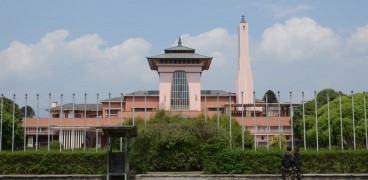Bardiya National Park formerly known as the Royal Bardia National Park, is the largest national park of Nepal. The conservational area with an area of 968 km sq is the most undisturbed national park of Nepal lying in the Terai region.
Along with Banke National Park, the Bardiya National Park forms the Tiger Conservation Unit Bardia Banke which spreads over 2,231 sq km of land. The protected area comprises of alluvial grasslands which is home to over 53 species of mammals like the Bengal tiger rhinoceros, elephants, and swamp deers.
Geographical location of Bardiya National Park
The conservational area lies in the far-western region of Nepal. The Karnali River borders the park in the western side while the Churia range and Siwalik Hills lies in the north.

Bardiya: Wildlife Sanctuary Beauty
Credit:tigerencounter.com
In the south, the Nepalgunj-Surkhet highway slightly forms its southern boundary. At the same time, the Geruwa river (a tributary of the Karnali River) creates a natural barrier to human settlements lying in the west.
The Babai River flows straight through the Bardiya National Park. The geographical coordinates of the area are 28°23′N 81°30′E.
How to reach the Bardiya National Park?
Catch an hour-long flight from the capital city followed by a few hrs on the road to reach the dense forests of Bardiya.
Thakurdwara, the park's headquarters lies about an hour away from the Nepalgunj-Surkhet highway. It can also be reached via road, passing Nepalgunj from where the conservational area is only about 2 hrs away.
Origins of BNP
The history of Bardiya National Park dates back to 1815 when Nepal lost parts of this region to the British East India Company due to the Sugauli Treaty.
It remained part of the colonies of British India for 45 years until it was returned in 1860 for supporting and recognizing the British Raj's suppression of the Indian Independence movement of 1857.

Caption: Elephant Safari Park Photography Adventure
368 km sq of land was named the Royal Hunting Reserve in 1969, and in 1976 it was gazetted as the Royal Karnali Wildlife Reserve.
Later in 1982, the conservation area was named Royal Bardia Wildlife Reserve and also included the Babai River Valley in 1984. The sanctuary was then given the national park status in 1988.
The former 1,500 people who used to reside in this area have been relocated elsewhere.
Flora of Bardiya National Park
Almost 70% of the conservational area is covered with thick, dense forests. The vegetation comprises of mixed savannah and riverine forests and grasslands.
According to botanists, Bardiya National Park comprises of 839 species of different floral plants, which are further divided into 140 species of dicots, 26 varieties of monocots, six types of fern, and one gymnosperm species.
The forests of the park are covered with trees of Sal and tall elephant grass which makes it an ideal habitat for different species of animals.
Wildlife in the Bardiya National Park
The varied range of vegetation of the conservational area has proven to be an excellent habitat for over 642 varieties of faunal species.
The lakes around the Karnali-Babai river system have recorded more than 125 species of fish. The rivers are also populated with a small number of gharials, 23 species of reptiles like the marsh-mugger crocodiles, and amphibians.
Birds
The Bardiya National Park is home to over 407 species of raptors. The most iconic birds of this area are sarus crane, lesser florican, peafowl, Bengal florican, bar-headed geese, white-rumped vulture, to name a few.
 The park also has regular visits from migratory birds like the jungle prinia, grey-crowned prinia, golden-headed cisticola, aberrant bush warbler, pale-footed bush warbler, and chestnut capped babbler.
The park also has regular visits from migratory birds like the jungle prinia, grey-crowned prinia, golden-headed cisticola, aberrant bush warbler, pale-footed bush warbler, and chestnut capped babbler.
Mammals
There are over 53 species of mammals residing in the protected area namely the Royal Bengal tiger, rhinoceros, swamp deer, wild elephant, and the Gangetic dolphin.
Rhinoceros are a significant part of the wildlife reserve, and about 58 rhinos were relocated from Chitwan to the Royal Bardia National Park until 2000. Studies show that about 67 individuals resided in the Babai Valley during 2000.
However, a survey conducted in 2006 showed a rapid decline in their population. Poaching was regarded as the main reason behind the decrease in their numbers.
Other surveys conducted in 2007 and 2008 confirmed the disappearance of these wild animals from the valley. As a result, the security around the conservational area was tightened, and as of 2015, 29 rhinos were recorded in the Bardiya National Park.
The park is also famous for wild elephants which started with two elephants bulls in 1985. They were named Kanchha and Raja Gaj.

Caption:Bardiya's Elephants Roam Freely
Five elephants were spotted entering the wildlife reserve in 1993, and the following year, other 16 individuals arrived. By the end of 1997, about 41 elephants were residing in the Babai Valley.
In a survey conducted in 2002, the officials recorded about 60 individuals roaming around the grassland of the Babai valley and the Karnali floodplain.
Things to do in Bardiya National Park:
- Bird Watching
- Butterfly Watching
- Jungle Safari
- Visit the Karnali-Chisapani Bridge
- Visit the Tharu Cultural Museum
- Visit the Crocodile Breeding Center
- Enjoy the walks and bicycling in Bardia
- Fishing at the Karnali-Babai rivers
For more information on National Parks of Nepal, please visit Hopnepal.com.
















